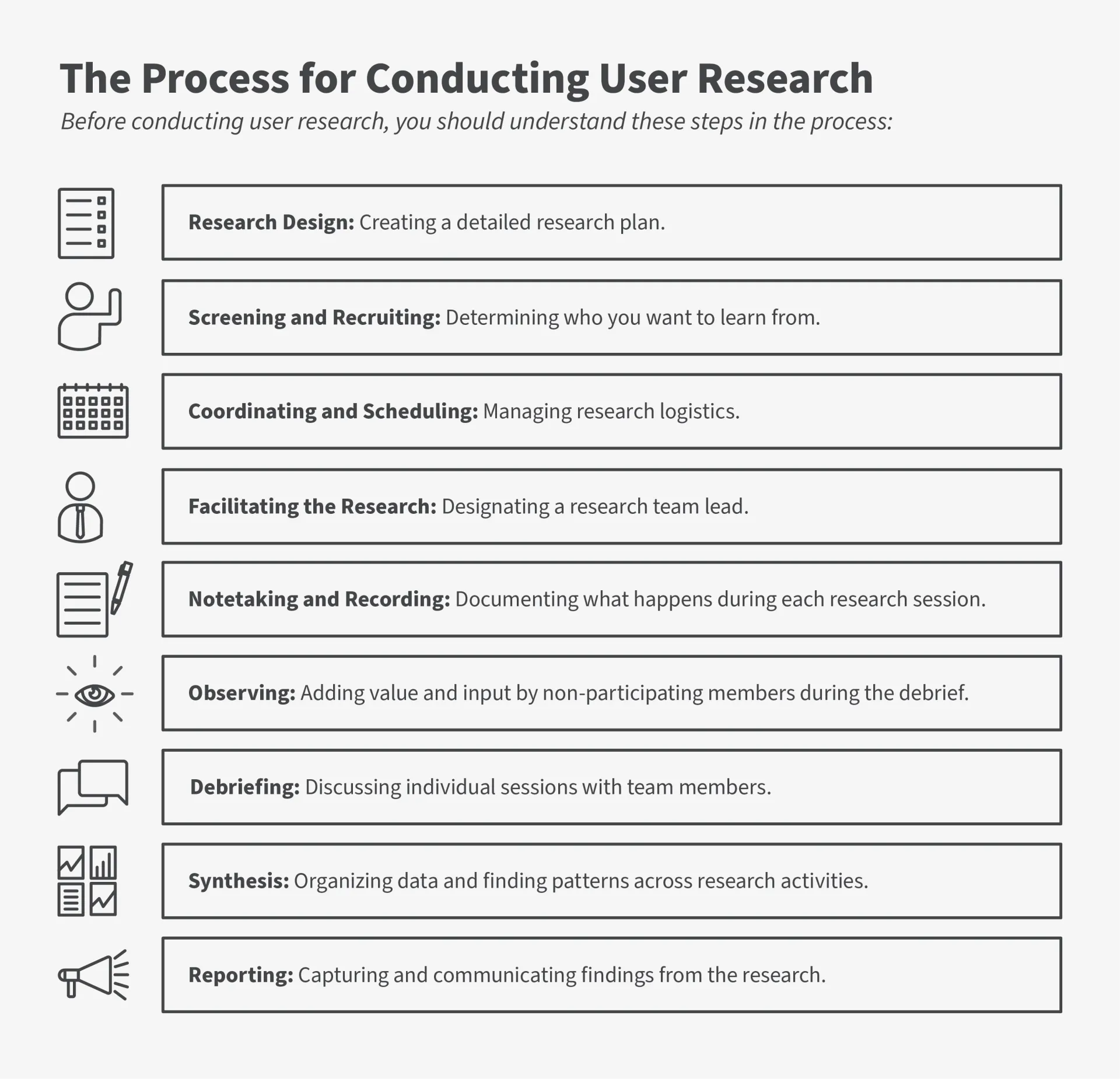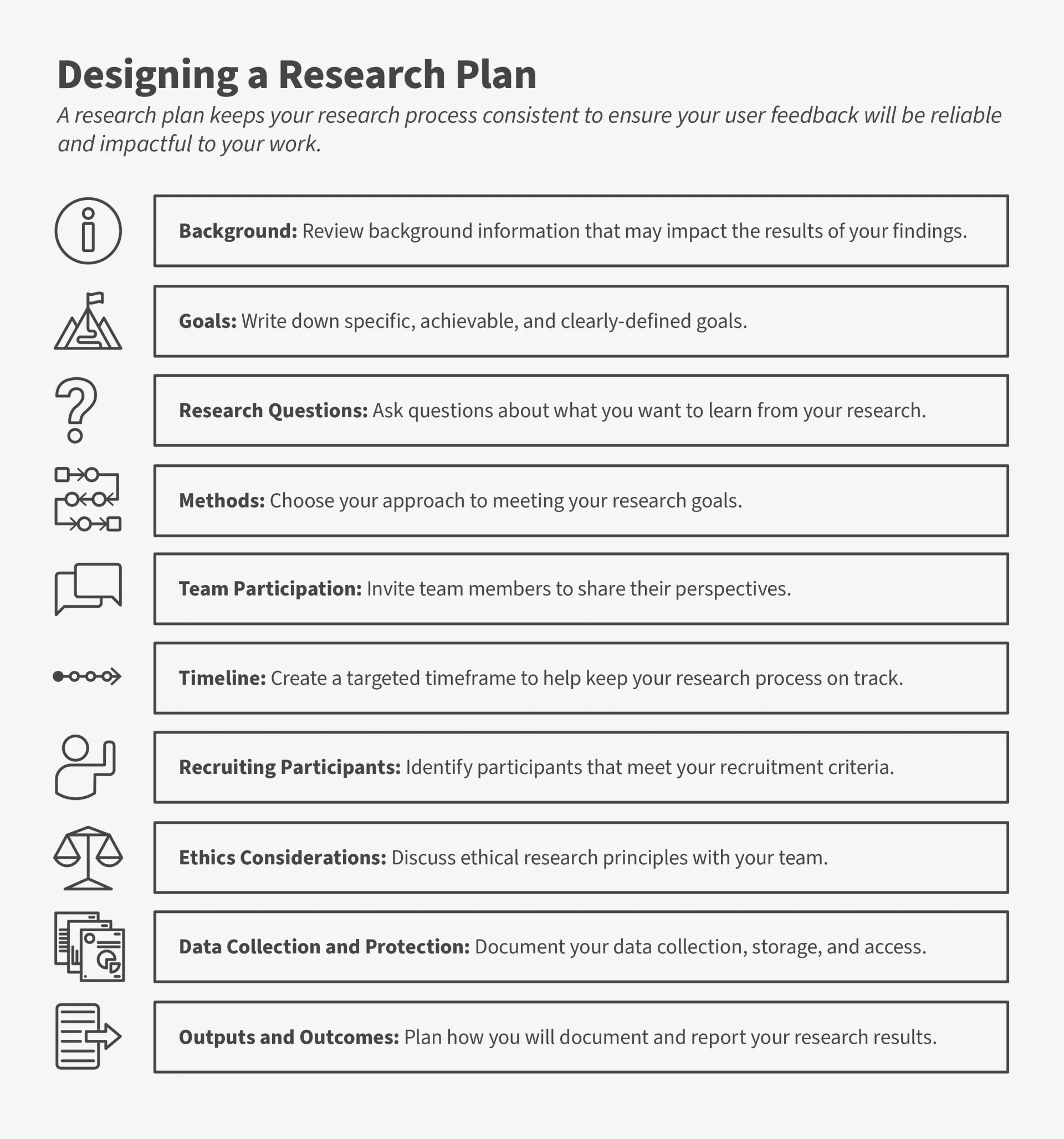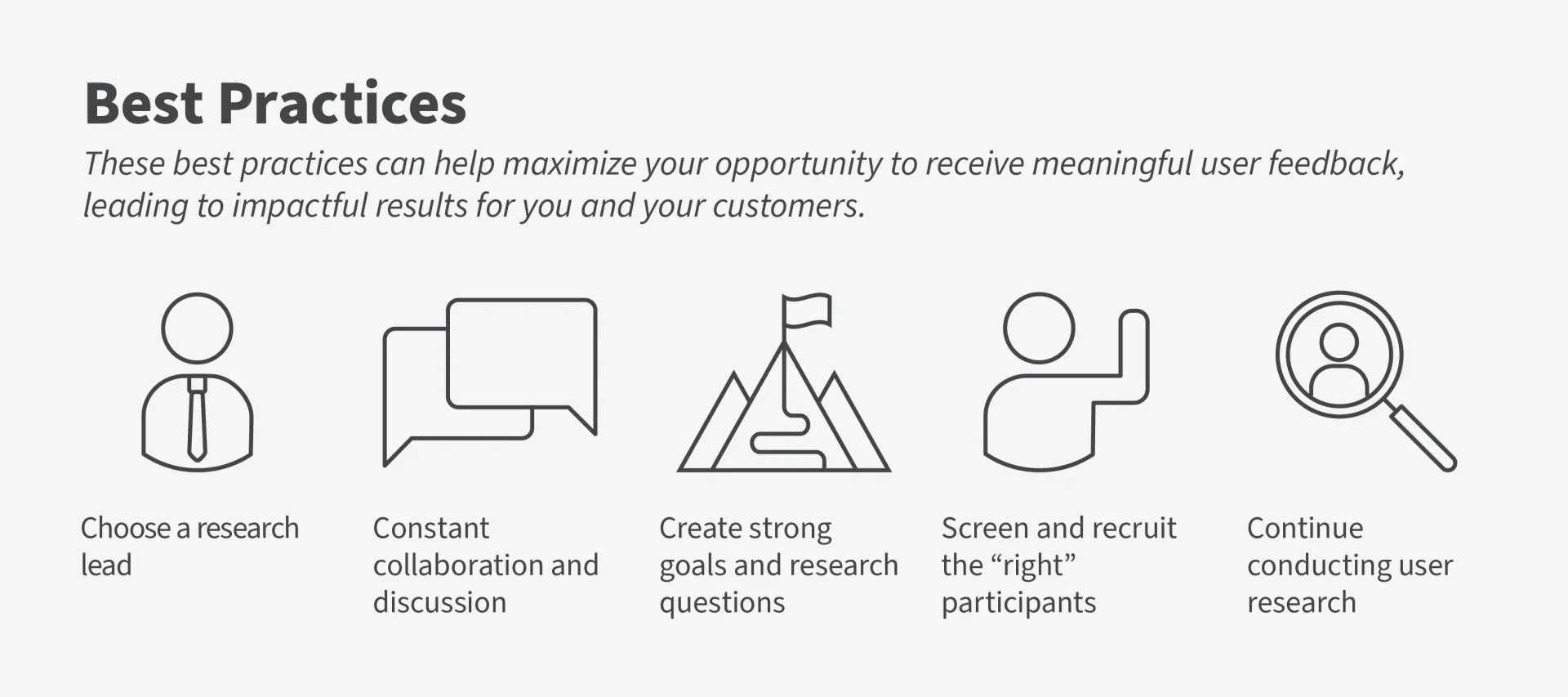Basics of User Research Lesson | 10 Minutes
Lesson Objectives
- Understand the process for conducting user research
- Understand what to include when designing a user research plan
- Understand the best practices for designing user research
Ready to learn more about your customers? Want to get the most out of user research?
Let’s examine steps you can take to ensure your research is set up to have the best possible outcomes.
The Process for Conducting User Research
Before you conduct user research, let's go through the steps in the process and the roles each of your team members will play.
The steps and roles in the user research process are:
- Research design: Creating a detailed research plan that sets the direction and goals for your research
- Screening and recruiting: Determining who you want to learn from, and inviting them to participate
- Coordinating and scheduling: Managing research logistics, including times, places, tools, participants, and team members
- Facilitating the research: Designating a research team lead and supporting your other team members
- Note-taking and recording: Documenting what happens during each research session
- Observing: Non-participating team members can add value and input during the debrief
- Debriefing: Discussing individual sessions with team members to reach a shared understanding
- Synthesis: Organizing data and finding patterns across research activities
- Reporting: Capturing and communicating findings from the research to share with stakeholders
Each step in the process is essential to the success of your research efforts. However, the first step, designing a research plan is particularly crucial because it sets the direction for conducting your user research.
Designing a Research Plan
Your user research plan will help you and your team stay organized and focused on your research goals.
So, what should you include in your user research plan?
- Background: Create a problem statement that establishes the context for doing the user research. For example, “We know it’s a lot of work for sponsors and beneficiaries to apply for family-based adjustment of status, but we need to learn more about what that burden looks and feels like.”
- Goals: Write your goals using specific verbs that describe actionable outputs. Your goals should be clearly defined and achievable through your research.
- Research questions: High-level questions that should be relevant, actionable, and practical that reflect what you want to learn from your research. These are not the questions you will ask participants.
- Methods: Your approach to meeting your research goals. You may choose one or more methods to help you answer your research questions. (EX: user interviews, card sorting, usability testing, etc.)
- Team participation: Invite team members who have had direct and indirect experience with your service/product to share their perspectives to help build a unified research plan.
- Timeline: A targeted time frame from start to finish is helpful for keeping your research process on track and to keep team members, stakeholders, and participants aware of the time commitment.
- Recruiting participants: Identify participants that meet your recruitment criteria. Consider starting with your most marginalized or historically disadvantaged customers. Ensure that people who are time taxed, need disability accommodation, or language assistance are included.
- Ethics considerations: Discuss the potential harms that participants might experience during the research. For example, disaster survivors may be re-traumatized by telling their story. Include specific actions for protecting participants emotionally and psychologically, as well as protecting their privacy and personally identifying information.
- Data collection and protection: Document what data you will collect, how it will be stored securely, who has access to it, and when it will be destroyed or disposed of and how that will be done.
- Outputs and outcomes: Plan how you will document and report your research results to address any changes that need to be made based on your research findings.
A detailed user research plan can make all the difference for you, your team members, stakeholders, and participants. Not only can it help you yield better user feedback, but it also ensures that everyone’s time is respected and used efficiently during the research process.
Best Practices for Designing User Research
Besides creating a detailed research plan, there are a few best practices you can follow to help you maximize your opportunity to receive meaningful user feedback.
Choose a research lead:
Your research lead is the team member that is responsible for setting the tone and agenda for all your research efforts. As the point of contact, your research lead must have the time, resources, and communication skills to keep team members, stakeholders, and participants informed throughout the research process.
Constant collaboration & discussion:
To make the most of your user research, your team should be in constant contact throughout the research process. Whether collaborating and discussing the research plan, debriefing after meeting with each participant, or synthesizing user feedback, your team should act as a unified group and keep your stakeholders up to date.
Create strong goals and research questions:
Your goals and research questions must be direct and achievable through your research findings. If your research findings cannot provide evidence either for or against your goals and questions, you need to rethink them. Avoid being vague about what you want to achieve and being too simplistic with yes or no style research questions.
Screen and recruit the “right” participants:
Be clear with your participant screening process. Ideally, you want a diverse group of users that reflect your customer base. However, there may be circumstances that call for a very specific group of customers to be recruited. The participants you seek to recruit will be dependent on what you are trying to achieve with your research.
Continue conducting user research:
As a team and/or organization, make time for continuous user research. Over time, policies change, services change, and most importantly users change. Keeping a pulse on those factors and more through continuous, iterative user research will help your team be proactive in designing products and services that meet the needs of your customers.
In Summary
To give yourself the best opportunity to receive meaningful user feedback, you must start with a detailed research plan and create a comprehensive outline for your research efforts.
At DHS, we are collecting powerful user feedback by conducting user research early and often throughout the lifecycle of our services and products to ensure we are providing our customers with the best possible experience.
Resources
Article:
Design & research in critical times (18F)
Two exercises for improving design research through reflective practice (18F)
Web Resource:
18F User Experience Design Guide: Research (18F)
18F User Experience Design Guide: Plan (18F)
Download:
Customer Experience Center of Excellence Playbook (GSA)
Video:
What is user research and why is it so important in developing services? (GDS)
Mitigating Bias While Building Research Practices (Digital.gov)



